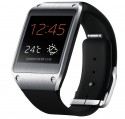Wristwatch-phones, cell-phone-wristwatches, smart watches… regardless of your favored moniker – this type of gadget is destined to become the next latest technological trend. You can bet it will blow up no later this year.
Apple has long been rumored to be working on this new thing for years, but somehow Samsung managed to be the first to release an actual smartphone with a wristwatch form factor – the Samsung Gear.
So what do we make out of the smartwatch? Is this a fad destined to be, or is there a potential usefulness here that may actually bring these things to massive ubiquity very soon? Let us see…
Points in Favor of the Smartwatch
Smartphones are great and all, but sometimes they can be annoying in the sense that you actually have to reach out for them, handle them, keep from dropping them while juggling other tasks, and so forth. So when you think about it, the concept of a smartphone-ish device that can be worn on the wrist is clearly genius. How marvelous to always keep an eye out for notifications, text messages and calls, with as little effort as glancing at your wrist – is that right?
Points against the Smartwatch
Functional, maybe so; but the smaller form factor does come at the expense of a smaller screen real estate, and judging from the latest news, these devices are meant to complement (not replace) current smartphones. This isn’t really that great, especially for those of us who feel they already carry too many gadgets and accessories along for the day. We may still want to wear an elegant, sustainable timepiece instead, keeping our technology to our phone. Also, while the idea of a wearable communications device has great appeal to many people, there are also many folks who get the feeling wristwatches belong in the past.
Alternative Smartwatch Concepts
For those who do fancy wearing a wristband that does much beyond time tracking, many alternatives should flourish soon… so it may be worth waiting for the right time.
At a base level, it’s likely that inexpensive models will flood the market just as soon as Apple releases its first smartwatch… which is very likely to occur within 2014. These first models should be all about complementing existing smartphones, which should make them reasonably inexpensive (after all it’s essentially a display that syncs with your phone via Bluetooth).
Actually, there are plenty of inexpensive models already available (mostly from China), but most of them still look rather clunky and unpolished. Regardless, a few concept already stand out from the pack even before there’s a pack – such as the Pebble phone: a smartwatch featuring e-ink screen that drew much attention recently by raising over 10 million dollars on Kickstarter. That’s 100x as much as their initial goal, which clearly shows how big the smart watch thing will be, and how eager the consumers are to get a hold of this upcoming gadget type.
Alternative Takes on the Smartwatch
With the eminent release of curved display smartphones – it shouldn’t take long before someone figures out a bracelet strap that allows wearing your actual smartphone around your forearm. That could make for a convenient, ergonomic and inexpensive way to carry around a phone at all times without sacrificing finger dexterity.
However this entire concept of using phones with a static form factor may seem just too outdated to make sense in a matter of a few years. Because immediately following the rise of curved displays next year, we should see the proliferation of flexible and expandable screens. And those are something with real potential for changing the communications game, as opposed to a stylistic touch-up to the way phones look.
How would you like to own a compact but self-sufficient smartwatch featuring a roll out screen that nearly covers your forearm, to maximize the usable screen size while keeping the form factor down? Don’t be surprised if you see such a thing become real before the decade is over.
In the meantime, you can bet smartwatches are here to stay. But you can also bet they won’t be around for many years until they become something entirely different from these initial prototypes we’re seeing now. If nothing else, they should evolve as autonomous devices, rather than as mere counterparts to the current smartphones.

